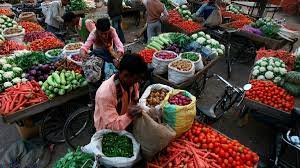
India’s consumer inflation has hit an 11-month low, registering at 4.83% in April compared to the previous year, as per data released by the Ministry of Statistics and Programme Implementation. However, despite this overall moderation, food prices have surged, reaching a four-month high.
The Consumer Price Index has consistently remained within the Reserve Bank of India’s (RBI) “tolerance range” of 4% (+/-2%) since September 2023. Despite this, food inflation has remained a concern, standing at 8.70% in April, well above the RBI’s acceptable limit.
The RBI’s monetary policy committee, noting the risks posed by food prices, opted to maintain the policy repo rate at 6.50% on April 5, marking the seventh consecutive steady rate decision.
RBI Governor Shaktikanta Das emphasized that while progress has been made in curbing inflation, the task is not complete, and efforts are ongoing to align inflation with the target on a sustainable basis.
Despite various measures taken, including bans on export for certain food items, prices of essential staples have remained high. Recently, the government lifted the ban on onion exports citing normal availability, stable prices, and robust output from the winter-sown crop.
However, to regulate exports and stabilize prices, a minimum export price (MEP) of $550 per tonne plus a 40% tariff has been imposed on outbound onion shipments.
Inflation trends for major food categories show an increase in cereal prices at 8.63% in April and a slight decrease in vegetable prices to 27.8%. Inflation in pulses, a significant protein source for many Indians, also saw a rise.
Rural households experienced a higher uptick in prices compared to urban areas, with rural inflation at 5.43% and urban inflation nearly steady at 4.11% in April.
The RBI’s forecast predicts a further easing of retail inflation to an average of 4.5% for the year, down from 5.4% in the previous fiscal year.
Sources By Agencies
 Digital Scoop India Official Platform of Digital Scoop India Featuring Latest & Best News #Articles #Bytes #Entertainment #DigitalScoopMagazine
Digital Scoop India Official Platform of Digital Scoop India Featuring Latest & Best News #Articles #Bytes #Entertainment #DigitalScoopMagazine



